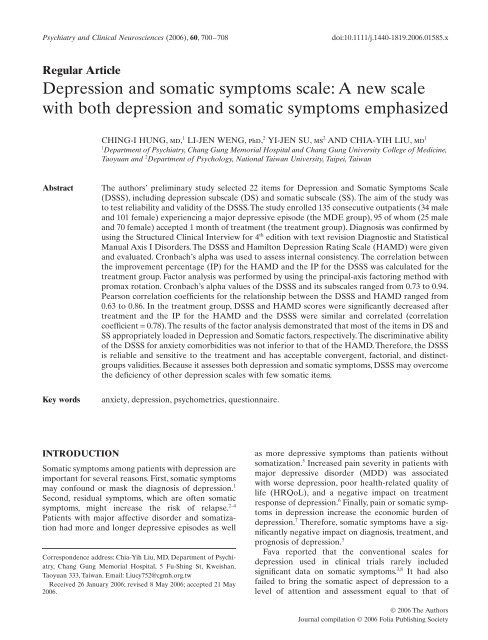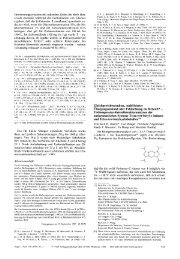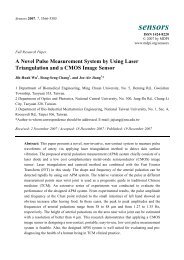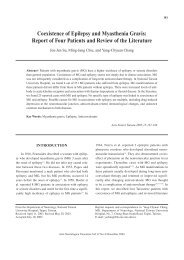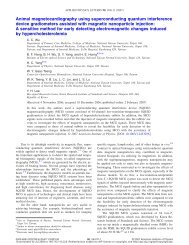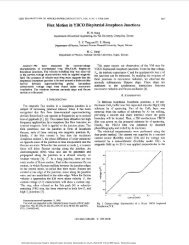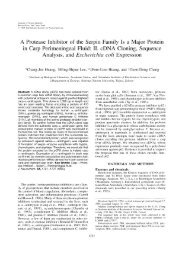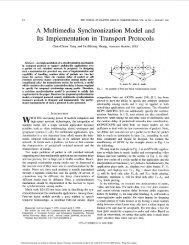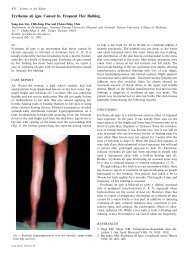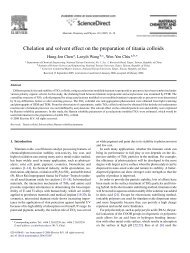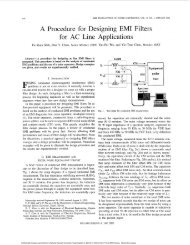Depression and somatic symptoms scale: A new scale with both ...
Depression and somatic symptoms scale: A new scale with both ...
Depression and somatic symptoms scale: A new scale with both ...
You also want an ePaper? Increase the reach of your titles
YUMPU automatically turns print PDFs into web optimized ePapers that Google loves.
Blackwell Publishing AsiaMelbourne, AustraliaPCNPsychiatry <strong>and</strong> Clinical Neurosciences1323-13162006 Folia Publishing Society2006606700708Original Article<strong>Depression</strong> <strong>and</strong> <strong>somatic</strong> <strong>symptoms</strong> <strong>scale</strong>C.-I. Hung et al.<br />
Psychiatry <strong>and</strong> Clinical Neurosciences (2006), 60, 700–708 doi:10.1111/j.1440-1819.2006.01585.x<br />
Regular Article<br />
<strong>Depression</strong> <strong>and</strong> <strong>somatic</strong> <strong>symptoms</strong> <strong>scale</strong>: A <strong>new</strong> <strong>scale</strong><br />
<strong>with</strong> <strong>both</strong> depression <strong>and</strong> <strong>somatic</strong> <strong>symptoms</strong> emphasized<br />
CHING-I HUNG, md, 1 LI-JEN WENG, phd, 2 YI-JEN SU, ms 2 AND CHIA-YIH LIU, md 1<br />
1 Department of Psychiatry, Chang Gung Memorial Hospital <strong>and</strong> Chang Gung University College of Medicine,<br />
Taoyuan <strong>and</strong> 2 Department of Psychology, National Taiwan University, Taipei, Taiwan<br />
Abstract The authors’ preliminary study selected 22 items for <strong>Depression</strong> <strong>and</strong> Somatic Symptoms Scale<br />
(DSSS), including depression sub<strong>scale</strong> (DS) <strong>and</strong> <strong>somatic</strong> sub<strong>scale</strong> (SS). The aim of the study was<br />
to test reliability <strong>and</strong> validity of the DSSS. The study enrolled 135 consecutive outpatients (34 male<br />
<strong>and</strong> 101 female) experiencing a major depressive episode (the MDE group), 95 of whom (25 male<br />
<strong>and</strong> 70 female) accepted 1 month of treatment (the treatment group). Diagnosis was confirmed by<br />
using the Structured Clinical Interview for 4 th edition <strong>with</strong> text revision Diagnostic <strong>and</strong> Statistical<br />
Manual Axis I Disorders. The DSSS <strong>and</strong> Hamilton <strong>Depression</strong> Rating Scale (HAMD) were given<br />
<strong>and</strong> evaluated. Cronbach’s alpha was used to assess internal consistency. The correlation between<br />
the improvement percentage (IP) for the HAMD <strong>and</strong> the IP for the DSSS was calculated for the<br />
treatment group. Factor analysis was performed by using the principal-axis factoring method <strong>with</strong><br />
promax rotation. Cronbach’s alpha values of the DSSS <strong>and</strong> its sub<strong>scale</strong>s ranged from 0.73 to 0.94.<br />
Pearson correlation coefficients for the relationship between the DSSS <strong>and</strong> HAMD ranged from<br />
0.63 to 0.86. In the treatment group, DSSS <strong>and</strong> HAMD scores were significantly decreased after<br />
treatment <strong>and</strong> the IP for the HAMD <strong>and</strong> the DSSS were similar <strong>and</strong> correlated (correlation<br />
coefficient = 0.78). The results of the factor analysis demonstrated that most of the items in DS <strong>and</strong><br />
SS appropriately loaded in <strong>Depression</strong> <strong>and</strong> Somatic factors, respectively. The discriminative ability<br />
of the DSSS for anxiety comorbidities was not inferior to that of the HAMD. Therefore, the DSSS<br />
is reliable <strong>and</strong> sensitive to the treatment <strong>and</strong> has acceptable convergent, factorial, <strong>and</strong> distinctgroups<br />
validities. Because it assesses <strong>both</strong> depression <strong>and</strong> <strong>somatic</strong> <strong>symptoms</strong>, DSSS may overcome<br />
the deficiency of other depression <strong>scale</strong>s <strong>with</strong> few <strong>somatic</strong> items.<br />
Key words anxiety, depression, psychometrics, questionnaire.<br />
INTRODUCTION<br />
Somatic <strong>symptoms</strong> among patients <strong>with</strong> depression are<br />
important for several reasons. First, <strong>somatic</strong> <strong>symptoms</strong><br />
may confound or mask the diagnosis of depression. 1<br />
Second, residual <strong>symptoms</strong>, which are often <strong>somatic</strong><br />
<strong>symptoms</strong>, might increase the risk of relapse. 2–4<br />
Patients <strong>with</strong> major affective disorder <strong>and</strong> somatization<br />
had more <strong>and</strong> longer depressive episodes as well<br />
Correspondence address: Chia-Yih Liu, MD, Department of Psychiatry,<br />
Chang Gung Memorial Hospital, 5 Fu-Shing St, Kweishan,<br />
Taoyuan 333, Taiwan. Email: Liucy752@cgmh.org.tw<br />
Received 26 January 2006; revised 8 May 2006; accepted 21 May<br />
2006.<br />
as more depressive <strong>symptoms</strong> than patients <strong>with</strong>out<br />
somatization. 5 Increased pain severity in patients <strong>with</strong><br />
major depressive disorder (MDD) was associated<br />
<strong>with</strong> worse depression, poor health-related quality of<br />
life (HRQoL), <strong>and</strong> a negative impact on treatment<br />
response of depression. 6 Finally, pain or <strong>somatic</strong> <strong>symptoms</strong><br />
in depression increase the economic burden of<br />
depression. 7 Therefore, <strong>somatic</strong> <strong>symptoms</strong> have a significantly<br />
negative impact on diagnosis, treatment, <strong>and</strong><br />
prognosis of depression. 3<br />
Fava reported that the conventional <strong>scale</strong>s for<br />
depression used in clinical trials rarely included<br />
significant data on <strong>somatic</strong> <strong>symptoms</strong>. 3,8 It had also<br />
failed to bring the <strong>somatic</strong> aspect of depression to a<br />
level of attention <strong>and</strong> assessment equal to that of<br />
© 2006 The Authors<br />
Journal compilation © 2006 Folia Publishing Society
<strong>Depression</strong> <strong>and</strong> <strong>somatic</strong> <strong>symptoms</strong> <strong>scale</strong> 701<br />
the psychological <strong>symptoms</strong>. 3,8 For example, the<br />
Hamilton <strong>Depression</strong> Rating Scale (HAMD) <strong>and</strong><br />
the Montgomery–Asberg <strong>Depression</strong> Rating Scale<br />
(MADRS) are the most common <strong>scale</strong>s used to evaluate<br />
depression. 9–11 Although the 17-item HAMD <strong>scale</strong><br />
contains eight items pertaining to <strong>somatic</strong> <strong>symptoms</strong>,<br />
six of the eight items are designed to identify vegetative<br />
<strong>symptoms</strong>, including insomnia, loss of appetite,<br />
loss of bodyweight, <strong>and</strong> decreased libido. Other<br />
<strong>somatic</strong> <strong>symptoms</strong> – for example, fatigue, chest tightness,<br />
palpitations, headache, muscle soreness, <strong>and</strong><br />
other types of pain – are coded for by only two items,<br />
thereby accounting for only six points, or 11.5% of the<br />
total score. 3,8 The fact that the codes for several <strong>somatic</strong><br />
<strong>symptoms</strong> are limited to two items makes it almost<br />
impossible to track specific <strong>somatic</strong> <strong>symptoms</strong> <strong>and</strong><br />
dimension. Among the 10 items for the MADRS <strong>scale</strong>,<br />
there are only two items for the vegetative <strong>symptoms</strong><br />
(decreased appetite <strong>and</strong> insomnia) <strong>and</strong> none for other<br />
<strong>somatic</strong> <strong>symptoms</strong>. However, <strong>scale</strong>s for depression<br />
<strong>with</strong>out relevant <strong>somatic</strong> <strong>symptoms</strong> are problematic<br />
for researchers in the field of depression. Studies of<br />
<strong>somatic</strong> issues in depression must use other tools to<br />
measure <strong>somatic</strong> severity, such as the visual analog<br />
<strong>scale</strong>, the 90-item Hopkins Symptom Checklist, 12<br />
Patient Health Questionnaire, 13 or HRQoL <strong>scale</strong>. 14<br />
However, these <strong>scale</strong>s are not specifically designed for<br />
depression <strong>and</strong> the question remains as to whether the<br />
<strong>somatic</strong> <strong>symptoms</strong> in these <strong>scale</strong>s can be used to<br />
accurately assess <strong>somatic</strong> severities in patients <strong>with</strong><br />
depression.<br />
The authors’ previous studies investigated the<br />
impact of headache on HRQoL <strong>and</strong> three psychometric<br />
<strong>scale</strong>s among patients <strong>with</strong> MDD. 15–17 The authors<br />
found that the difference in depressive severity<br />
between MDD patients <strong>with</strong> <strong>and</strong> <strong>with</strong>out migraine was<br />
partially due to <strong>somatic</strong> severity. However, no depression<br />
<strong>scale</strong> emphasizing <strong>somatic</strong> <strong>symptoms</strong> was available<br />
to further explore this difference. One study<br />
reported that adding HRQoL sub<strong>scale</strong>s for physical<br />
<strong>and</strong> social activity could improve the accuracy of<br />
predicting acute treatment response. 18 Therefore, a<br />
depression <strong>scale</strong> that emphasizes <strong>somatic</strong> <strong>symptoms</strong> is<br />
worth developing. In fact, the dem<strong>and</strong> for such a <strong>scale</strong><br />
becomes more necessary <strong>and</strong> urgent because <strong>somatic</strong><br />
<strong>symptoms</strong> have a great impact on the prognosis of<br />
depression 4–6 <strong>and</strong> <strong>new</strong> antidepressants also stress their<br />
effect in this area. 1<br />
Initially, 102 patients <strong>with</strong> MDD were enrolled to<br />
determine which items should be included in the<br />
<strong>Depression</strong> <strong>and</strong> Somatic Symptoms Scale (DSSS). 19 A<br />
total of 44 items were used in the preliminary DSSS,<br />
including 16 depression items <strong>and</strong> 28 <strong>somatic</strong> items, the<br />
latter included seven pain-related items. The prelimi-<br />
nary items for depression sub<strong>scale</strong> were modifications<br />
of the 4th edition Diagnostic <strong>and</strong> Statistical Manual<br />
(DSM-IV) criteria for MDE, HAMD or MADRS <strong>scale</strong><br />
items. 9,10,20 The preliminary items for <strong>somatic</strong> sub<strong>scale</strong><br />
were selected from several sources, including the<br />
HAMD <strong>scale</strong>, 10 the 90-item Hopkins Symptom Checklist,<br />
12 <strong>and</strong> the common <strong>somatic</strong> <strong>symptoms</strong> for MDD<br />
reported in the previous studies. 21–25 In selecting appropriate<br />
items for the DSSS, several principles were considered:<br />
(i) <strong>somatic</strong> items that could reflect the severity<br />
of depression or predict the occurrence of depression,<br />
or the ones <strong>with</strong> significant impact on clinical practice<br />
or HRQoL; 1,21–26 (ii) <strong>somatic</strong> <strong>symptoms</strong> that were common<br />
in the present study <strong>and</strong> previous studies for<br />
depression; <strong>and</strong> (iii) <strong>somatic</strong> <strong>symptoms</strong> that improve<br />
Cronbach’s alpha value for DSSS. The final DSSS was<br />
composed of 22 items <strong>with</strong> two major sub<strong>scale</strong>s, the<br />
depression sub<strong>scale</strong> (DS) <strong>and</strong> the <strong>somatic</strong> sub<strong>scale</strong><br />
(SS). The DS had 12 items, including three vegetative<br />
<strong>symptoms</strong> <strong>and</strong> fatigue, <strong>and</strong> the SS had 10 items, including<br />
five pain items, which comprised the pain sub<strong>scale</strong><br />
(PS). Three vegetative <strong>symptoms</strong> (insomnia, poor<br />
appetite, <strong>and</strong> loss of interest in sex) <strong>and</strong> fatigue were<br />
included in DS but not in SS because three of the four<br />
<strong>symptoms</strong> were criteria for MDE <strong>and</strong> the four <strong>symptoms</strong><br />
were also included in the HAMD <strong>scale</strong>. This<br />
design made DS more compatible <strong>with</strong> MDE criteria,<br />
HAMD, <strong>and</strong> other <strong>scale</strong>s for depression. The preliminary<br />
results showed that the DSSS <strong>and</strong> HAMD were<br />
significantly correlated, <strong>and</strong> the Cronbach’s alpha of<br />
the DSSS <strong>and</strong> all sub<strong>scale</strong>s fell <strong>with</strong>in an acceptable<br />
range. The form of the DSSS is shown in Appendix I.<br />
The DS items were even-numbered plus item 21<br />
(fatigue) <strong>and</strong> the SS items were odd-numbered except<br />
for item 21. The purpose of this study was to describe<br />
the psychometric characteristics of the DSSS by assessing<br />
reliability (by evaluating the Cronbach’s alpha <strong>and</strong><br />
test–retest reliability) <strong>and</strong> validity (by testing the correlation<br />
between DSSS <strong>and</strong> HAMD scores, their sensitivity<br />
to treatment, <strong>and</strong> correlation of improvement<br />
percentages [IP] between the DSSS <strong>and</strong> HAMD, factorial<br />
validity, <strong>and</strong> distinct-groups validity).<br />
SUBJECTS AND METHODS<br />
Four groups (major depressive episode [MDE] group,<br />
non-MDE group, treatment group, <strong>and</strong> test–retest<br />
group) were studied. Patients in the MDE group came<br />
from the project entitled ‘The impact of headache <strong>and</strong><br />
<strong>somatic</strong> <strong>symptoms</strong> on MDD II’, which was conducted<br />
from January 2004 to January 2005 in the psychiatric<br />
outpatient clinics of Chang Gung Memorial Hospital,<br />
Taoyuan, Taiwan. This project was approved by the<br />
institutional review board of the Chang Gung Memo-<br />
© 2006 The Authors<br />
Journal compilation © 2006 Folia Publishing Society
702 C.-I. Hung et al.<br />
rial Hospital. Study participants were recruited from<br />
consecutive outpatients, 18–65 years of age, who had<br />
not received antidepressant or other psychotropic drug<br />
treatment <strong>with</strong>in the past 2 weeks. Screening included<br />
an interview <strong>with</strong> a board-certified psychiatrist using<br />
the Structured Clinical Interview for DSM-IV-text<br />
revision (TR) Axis I Disorders. 27 Patients who met the<br />
DSM-IV-TR criteria for MDD 20 <strong>and</strong> experienced a<br />
MDE were enrolled. Seven anxiety comorbidities were<br />
diagnosed by using the Structured Clinical Interview. 27<br />
The course of depression was clarified. Chronic depression<br />
was defined as chronic major depression for more<br />
than 2 years, dysthymic disorder plus current MDE, or<br />
previous MDE <strong>with</strong>out full remission plus current<br />
MDE <strong>with</strong> a total course of more than 2 years. 28<br />
To minimize confounding of <strong>somatic</strong> <strong>symptoms</strong> by<br />
other medical conditions, substance abuse, or psychotic<br />
<strong>symptoms</strong>, the following exclusion criteria were established:<br />
(i) a history of substance dependence or abuse<br />
<strong>with</strong>out full remission in the previous month; (ii) psychotic<br />
<strong>symptoms</strong>, catatonic features, or severe psychomotor<br />
retardation <strong>with</strong> obvious difficulty being<br />
interviewed; <strong>and</strong> (iii) regular treatment <strong>with</strong> medications<br />
for medical diseases, such as hypertension or diabetes<br />
mellitus.<br />
In enrolling the non-MDE group, the same exclusion<br />
<strong>and</strong> inclusion criteria, which were applied to the MDE<br />
group, were used except for fulfilling MDD in a MDE.<br />
Therefore, patients who were not in MDE were<br />
enrolled in the non-MDE group. The enrolment of<br />
consecutive subjects in the MDE <strong>and</strong> non-MDE<br />
groups started at the same time. Enrolment in the<br />
MDE group lasted 1 year <strong>and</strong> in the non-MDE group<br />
for 4 months. Written informed consent was obtained<br />
from all subjects prior to the study enrolment.<br />
After subjects were enrolled, subjects were<br />
requested to finish the self-administrated DSSS. Psychiatrists,<br />
who were blind to the DSSS results <strong>and</strong> psychiatric<br />
diagnoses, evaluated the HAMD score. In<br />
calculating the DSSS score, ‘Absent’ was scored as 0<br />
points, ‘Mild’ as 1 point, ‘Moderate’ as 2 points, <strong>and</strong><br />
‘Severe’ as 3 points. The total scores on the DSSS or its<br />
sub<strong>scale</strong>s were calculated by adding the appropriate<br />
item scores. The scores on the DSSS <strong>and</strong> its sub<strong>scale</strong>s<br />
<strong>and</strong> the HAMD between the MDE <strong>and</strong> non-MDE<br />
groups were also compared. Moreover, the correlation<br />
between the HAMD <strong>and</strong> the DSSS <strong>and</strong> its sub<strong>scale</strong><br />
scores were calculated for the different groups.<br />
To underst<strong>and</strong> the sensitivity of the DSSS to treatment<br />
<strong>and</strong> the correlation between degree of improvement<br />
in the DSSS <strong>and</strong> HAMD scores, the MDE<br />
patients were treated for 1 month by pharmacological<br />
therapy. At 1 month later, DSSS was given <strong>and</strong><br />
HAMD was re-evaluated by the same psychiatrist.<br />
© 2006 The Authors<br />
Journal compilation © 2006 Folia Publishing Society<br />
Those who accepted the 1 -month follow-up treatment<br />
were considered to be in the treatment group. Scores<br />
on the DSSS <strong>and</strong> its sub<strong>scale</strong>s before <strong>and</strong> after treatment<br />
were compared to determine the test’s sensitivity<br />
to treatment. The IP for the DSSS <strong>and</strong> its sub<strong>scale</strong>s <strong>and</strong><br />
the HAMD were also compared. The IP calculation<br />
was:<br />
(scores before treatment – scores after<br />
treatment) × 100%/scores before treatment<br />
Moreover, the correlation between IP for the DSSS<br />
<strong>and</strong> its sub<strong>scale</strong>s <strong>and</strong> the HAMD was calculated.<br />
The internal consistency of the DSSS <strong>and</strong> its sub<strong>scale</strong>s<br />
in the MDE, non-MDE, <strong>and</strong> the treatment<br />
groups were assessed by Cronbach’s alpha. To test the<br />
test–retest reliability of the DSSS, psychiatric outpatients<br />
were enrolled who met two criteria: (i) received<br />
treatment in the psychiatric clinic for depression for at<br />
least 3 months <strong>and</strong> were in a stable condition according<br />
to patients’ self-report <strong>and</strong> chart review; <strong>and</strong> (ii) did<br />
not expect change in medications or treatment profile<br />
in the following week. Subjects were given the DSSS at<br />
the index visit <strong>and</strong> 1 week later. Then, the Pearson correlation<br />
was calculated for the correlation between<br />
scores on the DSSS in the index visit <strong>and</strong> scores<br />
obtained 1 week later.<br />
The factor structure of DSSS was investigated in the<br />
MDE <strong>and</strong> non-MDE groups. The authors submitted<br />
the DSSS items to a principal-axis factor analysis <strong>with</strong><br />
promax rotation. A two-factor solution appeared to be<br />
the best fit based on two considerations. First, in their<br />
initial hypothesis for designing DSSS, it was composed<br />
of two major sub<strong>scale</strong>s: DS <strong>and</strong> SS. Second, the scree<br />
test revealed the possibility of a two or three-factor<br />
solution.<br />
To test the discriminative validity of DSSS, subjects<br />
in the MDE group were divided into the anxiety<br />
comorbidity subgroup <strong>and</strong> the nonanxiety comorbidity<br />
subgroup. The differences of scores between the two<br />
groups were compared. Authors selected to test the<br />
discriminative ability for anxiety comorbidities<br />
because the purpose of DSSS was to emphasize<br />
<strong>somatic</strong> <strong>symptoms</strong>, which were related to anxiety.<br />
All statistical analyses were carried out using the<br />
Statistical Package for the Social Sciences for Windows<br />
10.0 (SPSS Inc., Chicago, IL, USA). Pearson<br />
correlation was used in these situations: the correlation<br />
of the DSSS <strong>and</strong> its sub<strong>scale</strong> scores <strong>with</strong> the<br />
HAMD scores, the correlation between the IP for the<br />
DSSS <strong>and</strong> its sub<strong>scale</strong>s <strong>and</strong> that for the HAMD, <strong>and</strong><br />
test–retest reliability. Independent or paired t-test was<br />
used in appropriate situations. A P-value less than<br />
0.05 was considered statistically significant in all of the<br />
tests.
<strong>Depression</strong> <strong>and</strong> <strong>somatic</strong> <strong>symptoms</strong> <strong>scale</strong> 703<br />
Table 1. Age, gender, <strong>and</strong> the scores on the Hamilton <strong>Depression</strong> Rating Scale <strong>and</strong> <strong>Depression</strong> <strong>and</strong> Somatic Symptoms Scale<br />
for the different groups †<br />
MDE group Non-MDE group Test–retest group (at baseline) Test–retest group (1 week later)<br />
Sample size 135 139 46 46<br />
Age (years) 30.2 ± 8.4 32.6 ± 8.1 38.1 ± 12.0 38.1 ± 12.0<br />
Gender (M : F) 34:101 50:89 17:29 17:29<br />
HAMD 23.4 ± 4.5 12.5 ± 5.5 – –<br />
DSSS 41.3 ± 10.3 23.2 ± 10.7 20.8 ± 14.7 19.3 ± 14.1<br />
<strong>Depression</strong> sub<strong>scale</strong> 25.3 ± 5.1 13.7 ± 6.0 11.7 ± 7.8 11.3 ± 8.1<br />
Somatic sub<strong>scale</strong> 16.0 ± 6.6 9.5 ± 6.3 9.2 ± 7.5 7.9 ± 7.0<br />
Pain sub<strong>scale</strong> 7.7 ± 3.7 4.4 ± 3.2 4.7 ± 4.1 4.1 ± 3.9<br />
† Differences in the mean scores on the HAMD <strong>and</strong> DSSS <strong>and</strong> sub<strong>scale</strong>s between the MDE group <strong>and</strong> non-MDE group were<br />
significant (P < 0.01).<br />
DSSS, <strong>Depression</strong> <strong>and</strong> Somatic Symptoms Scale; HAMD, Hamilton <strong>Depression</strong> Rating Scale; MDE group, subjects <strong>with</strong><br />
major depressive disorder currently in a major depressive episode; non-MDE group, subjects not in a major depressive episode.<br />
RESULTS<br />
Sample characteristics <strong>and</strong> scores in<br />
different groups<br />
The sample size, mean age, mean scores on the HAMD<br />
<strong>and</strong> the DSSS <strong>and</strong> its sub<strong>scale</strong>s among different groups<br />
are shown in Table 1. The MDE group’s scores on the<br />
DSSS <strong>and</strong> its sub<strong>scale</strong>s <strong>and</strong> the HAMD were significantly<br />
different from the non-MDE group’s scores<br />
(P < 0.01).<br />
Among the 135 subjects in the MDE group, 95<br />
(70.4%; 25 men <strong>and</strong> 70 women; mean age,<br />
31.3 ± 8.2 years) completed the required 1 -month<br />
follow-up visit <strong>and</strong>, therefore, were considered as the<br />
treatment group. The HAMD scores at baseline<br />
(23.8 ± 4.9) in 40 subjects (29.6%) who dropped out<br />
were not significantly different from those of the<br />
treatment group (23.3 ± 4.4). The coefficient of variance<br />
(st<strong>and</strong>ard deviation/mean) of the HAMD scores<br />
in the treatment group (at the 1 month follow-up<br />
point) was higher than in the MDE group (at baseline;<br />
0.55 vs. 0.19). Therefore, the HAMD scores in<br />
the MDE group were more homogeneous, compared<br />
to those in the treatment group after the 1-month<br />
treatment.<br />
Internal consistency reliability<br />
The Cronbach’s alpha values for the different groups<br />
are shown in Table 2. All Cronbach’s alpha values of<br />
the DSSS <strong>and</strong> SS for the three groups were >0.8 <strong>and</strong><br />
the Cronbach’s alpha values of the DS <strong>and</strong> PS were<br />
in an acceptable range (>0.7). Of the groups, the<br />
treatment group had a higher Cronbach’s alpha<br />
value.<br />
Table 2. The Cronbach’s alpha of the <strong>Depression</strong> <strong>and</strong><br />
Somatic Symptoms Scale <strong>and</strong> its sub<strong>scale</strong>s †<br />
Test–retest reliability<br />
MDE group<br />
Non-MDE<br />
group<br />
Treatment<br />
group<br />
DSSS 0.87 0.88 0.94<br />
<strong>Depression</strong> sub<strong>scale</strong> 0.73 0.79 0.90<br />
Somatic sub<strong>scale</strong> 0.88 0.88 0.90<br />
Pain sub<strong>scale</strong> 0.82 0.77 0.85<br />
† The Cronbach’s alpha values in the MDE <strong>and</strong> the non-<br />
MDE groups were obtained at baseline <strong>and</strong> the results in the<br />
treatment group were obtained at the 1-month follow-up<br />
point.<br />
DSSS, <strong>Depression</strong> <strong>and</strong> Somatic Symptoms Scale; MDE<br />
group (n = 135), subjects <strong>with</strong> major depressive disorder<br />
currently in a major depressive episode; non-MDE group<br />
(n = 139), subjects not in a major depressive episode;<br />
Treatment group (n = 95), subjects in MDE group who<br />
accepted 1 month of treatment.<br />
The scores of DSSS at the index visit <strong>and</strong> 1 week later<br />
are shown in Table 1. The difference in DSSS scores<br />
between the two evaluations was not significant as indicated<br />
by the paired t-test. The Pearson correlation<br />
coefficients calculated between the DSSS scores at the<br />
index visit <strong>and</strong> 1 week later were as follows: DSSS,<br />
0.92; DS, 0.88; SS, 0.90; <strong>and</strong> PS, 0.90 (all P < 0.01).<br />
Convergent validity <strong>and</strong> sensitivity to treatment<br />
The correlation between the scores on the HAMD <strong>and</strong><br />
DSSS are shown in Table 3. The scores on the DSSS<br />
© 2006 The Authors<br />
Journal compilation © 2006 Folia Publishing Society
704 C.-I. Hung et al.<br />
<strong>and</strong> its sub<strong>scale</strong>s were significantly correlated <strong>with</strong><br />
those on the HAMD. Among the three groups, the correlation<br />
between the scores on the HAMD <strong>and</strong> DSSS<br />
was higher for the treatment group than for the MDE<br />
or non-MDE groups. Among DSSS sub<strong>scale</strong>s, DS score<br />
was best correlated <strong>with</strong> HAMD score.<br />
Table 3. The Pearson correlation coefficients of the Hamilton<br />
<strong>Depression</strong> Rating Scale <strong>and</strong> <strong>Depression</strong> <strong>and</strong> Somatic<br />
Symptoms Scale †‡<br />
MDE<br />
group<br />
Non-MDE<br />
group<br />
© 2006 The Authors<br />
Journal compilation © 2006 Folia Publishing Society<br />
Treatment<br />
group<br />
HAMD – DSSS 0.63 0.66 0.86<br />
HAMD – DS 0.65 0.68 0.84<br />
HAMD – SS 0.49 0.48 0.78<br />
HAMD – PS 0.39 0.50 0.71<br />
DSSS – DS 0.84 0.87 0.95<br />
DSSS – SS 0.91 0.88 0.93<br />
DSSS – PS 0.82 0.81 0.87<br />
DS – SS 0.54 0.52 0.77<br />
DS – PS 0.45 0.49 0.72<br />
SS – PS 0.93 0.91 0.93<br />
† The Pearson correlation coefficients in the MDE <strong>and</strong> the<br />
non-MDE groups were obtained at baseline <strong>and</strong> the results<br />
in the treatment group were obtained at the 1-month followup<br />
point.<br />
‡ All these correlations were statistically significant<br />
(P < 0.01).<br />
DS, <strong>Depression</strong> Sub<strong>scale</strong>; DSSS, <strong>Depression</strong> <strong>and</strong> Somatic<br />
Symptoms Scale; HAMD, Hamilton <strong>Depression</strong> Rating<br />
Scale; MDE group (n = 135), subjects <strong>with</strong> major depressive<br />
disorder currently in a major depressive episode; non-MDE<br />
group (n = 139), subjects not in a major depressive episode;<br />
PS, Pain Sub<strong>scale</strong>; SS, Somatic Sub<strong>scale</strong>; Treatment group<br />
(n = 95), subjects in MDE group who accepted one month of<br />
treatment.<br />
The scores on the different <strong>scale</strong>s before <strong>and</strong> after<br />
treatment are shown in Table 4. The scores on the<br />
HAMD <strong>and</strong> DSSS decreased significantly post treatment<br />
(all P-values 0.35 on Factor 1. Nine items in the DS loaded on Factor<br />
2 <strong>with</strong> a factor loading >0.3. Insomnia, loss of interest<br />
in sex, <strong>and</strong> irritable mood did not appropriately<br />
load on <strong>both</strong> factors.<br />
In the non-MDE group, Factor 1 included all items<br />
in the SS <strong>with</strong> a factor loading >0.4. All items in the DS<br />
except for ‘unable to concentrate’, ‘insomnia’, <strong>and</strong><br />
‘fatigue’ had a factor loading >0.3 in Factor 2. Three<br />
items in the DS, ‘anxious’, ‘unable to concentrate’, <strong>and</strong><br />
‘fatigue’ tended to load on <strong>both</strong> factors.<br />
The two factors were moderately correlated (correlation<br />
coefficient = 0.51 in the MDE group <strong>and</strong> 0.45<br />
in the non-MDE group). The two-factor solution<br />
accounted for 34.1% of the variance in the MDE group<br />
<strong>and</strong> 35.5% of that in the non-MDE group.<br />
Table 4. The improvement percentage for all <strong>scale</strong>s <strong>and</strong> the Pearson correlation coefficients between improvement percentages<br />
for the Hamilton <strong>Depression</strong> Rating Scale <strong>and</strong> <strong>Depression</strong> <strong>and</strong> Somatic Symptoms Scale in the treatment group (n = 95)<br />
Scores before treatment Scores post treatment † IP (%) ‡ Correlation coefficients §<br />
HAMD 23.3 ± 4.4 12.8 ± 7.1 44.9 ± 29.3 –<br />
DSSS 41.6 ± 10.1 23.5 ± 13.2 42.6 ± 35.9 0.78<br />
<strong>Depression</strong> sub<strong>scale</strong> 25.2 ± 5.2 13.9 ± 7.6 43.5 ± 34.6 0.81<br />
Somatic sub<strong>scale</strong> 16.4 ± 6.0 9.6 ± 6.4 39.3 ± 46.6 0.61<br />
Pain sub<strong>scale</strong> 7.9 ± 3.5 4.9 ± 3.5 37.2 ± 52.0 0.51<br />
† Scores post treatment decreased significantly for all <strong>scale</strong>s <strong>and</strong> sub<strong>scale</strong>s (P < 0.01).<br />
‡ The IP was calculated as follows: (scores before treatment – scores after treatment) × 100%/scores before treatment.<br />
§ The Pearson correlations between the IP for the HAMD <strong>and</strong> DSSS were significant (P < 0.01).<br />
DSSS, <strong>Depression</strong> <strong>and</strong> Somatic Symptoms Scale; HAMD, Hamilton <strong>Depression</strong> Rating Scale; IP, improvement percentage.
<strong>Depression</strong> <strong>and</strong> <strong>somatic</strong> <strong>symptoms</strong> <strong>scale</strong> 705<br />
Table 5. Factor analysis of <strong>Depression</strong> <strong>and</strong> Somatic Symptoms Scale by using the principal-axis factoring method <strong>with</strong> promax<br />
rotation<br />
Distinct-groups validity<br />
The percentage <strong>and</strong> score of anxiety comorbidities <strong>and</strong><br />
chronic depression are shown in Table 6. Chronic<br />
depression <strong>and</strong> all anxiety comorbidities except for<br />
generalized anxiety disorder (GAD) had higher scores<br />
on the HAMD <strong>and</strong> DSSS. Among seven anxiety<br />
comorbidities, significant differences of scores between<br />
anxiety comorbidity subgroup versus non-anxiety<br />
comorbidity subgroup were noted in five anxiety<br />
comorbidities by using the DSSS. However, the<br />
HAMD only could differentiate the severity of three<br />
anxiety comorbidities. Significant differences of scores<br />
in the DS <strong>and</strong> SS also were noted in four anxiety<br />
comorbidities.<br />
DISCUSSION<br />
The scores on the DSSS <strong>and</strong> its sub<strong>scale</strong>s were significantly<br />
correlated <strong>with</strong> those on the HAMD. This correlation<br />
was less for the MDE group than the<br />
treatment group. This might be partially attributed to<br />
more homogeneity in severity of depression in the<br />
MDE group Non-MDE group<br />
Factor 1 Factor 2 Factor 1 Factor 2<br />
Somatic sub<strong>scale</strong><br />
1. Headache 0.58 −0.02 0.41 0.18<br />
3. Tightness in the chest 0.36 0.41 0.58 0.13<br />
5. Muscle tension 0.75 −0.17 0.77 −0.10<br />
7. Back pain 0.70 −0.06 0.69 −0.08<br />
9. Dizziness 0.47 0.24 0.64 −0.01<br />
11. Chest pain 0.54 0.26 0.63 −0.06<br />
13. Neck or shoulder pain 0.78 −0.12 0.54 0.08<br />
15. Shortness of breath or difficulty breathing 0.46 0.28 0.67 −0.02<br />
17. Soreness in more than half of the body’s muscles 0.95 −0.25 0.78 −0.09<br />
19. Palpitations or increased heart rate<br />
<strong>Depression</strong> sub<strong>scale</strong><br />
0.36 0.43 0.69 0.05<br />
2. Loss of interest in daily or leisure activities −0.11 0.58 −0.25 0.85<br />
4. Insomnia 0.14 0.16 0.13 0.05<br />
6. Irritable mood 0.21 0.16 0.15 0.34<br />
8. Unable to feel happy or decreased ability to feel happy −0.20 0.66 −0.03 0.76<br />
10. Depressed mood or tearful −0.01 0.50 0.07 0.64<br />
12. Feelings of self-reproach or guilt −0.08 0.50 0.20 0.44<br />
14. Loss of interest in sex 0.21 0.06 0.01 0.47<br />
16. Anxious or nervous 0.14 0.51 0.38 0.31<br />
18. Unable to concentrate 0.05 0.51 0.29 0.28<br />
20. Thoughts of death or suicidal ideas −0.12 0.64 0.03 0.39<br />
21. Fatigue or loss of energy 0.25 0.42 0.31 0.29<br />
22. Decreased appetite or loss of appetite 0.08 0.34 −0.02 0.48<br />
MDE group (n = 135), subjects <strong>with</strong> major depressive disorder currently in a major depressive episode; non-MDE group<br />
(n = 139), subjects not in a major depressive episode.<br />
MDE group (at baseline) than in the treatment group<br />
(at the 1 -month follow-up point) because subjects in<br />
the treatment group might have different degrees of<br />
improvement after the 1-month treatment. Among the<br />
DSSS sub<strong>scale</strong>s, DS was most correlated <strong>with</strong> the<br />
HAMD. This result was compatible <strong>with</strong> the design of<br />
the DSSS because the items in the DS were modified<br />
items from the HAMD <strong>and</strong> based on DSM-IV criteria<br />
for MDE.<br />
The scores on the DSSS <strong>and</strong> its sub<strong>scale</strong>s significantly<br />
decreased after treatment. The IP for the<br />
HAMD <strong>and</strong> DSSS were similar <strong>and</strong> significantly correlated<br />
(Table 4). These results demonstrated that the<br />
DSSS was sensitive to treatment, <strong>and</strong> its validity as a<br />
tool to monitor the severity of depression during treatment<br />
was good.<br />
The Cronbach’s alpha values for the DSSS <strong>and</strong> SS<br />
were good (>0.8) <strong>and</strong> those for the DS <strong>and</strong> PS were<br />
acceptable (>0.7). The test–retest reliability of scores<br />
on the DSSS at baseline was also highly correlated <strong>with</strong><br />
scores 1 week later, indicating that the reliability of the<br />
DSSS was acceptable.<br />
© 2006 The Authors<br />
Journal compilation © 2006 Folia Publishing Society
706 C.-I. Hung et al.<br />
Table 6. The scores (mean ± st<strong>and</strong>ard deviation) of the Hamilton <strong>Depression</strong> Rating Scale <strong>and</strong> the <strong>Depression</strong> <strong>and</strong> Somatic<br />
Symptoms Scale between the comorbid group versus the non-comorbid group among 135 subjects <strong>with</strong> major depressive<br />
disorder †<br />
In the factor analysis, most of the items in the DS<br />
<strong>and</strong> SS loaded on the <strong>Depression</strong> factor <strong>and</strong> the<br />
Somatic factor, respectively. Insomnia, loss of interest<br />
in sex, <strong>and</strong> irritable mood in the MDE group did not<br />
appropriately load on <strong>both</strong> factors. However, the three<br />
<strong>symptoms</strong> were common depressive <strong>symptoms</strong> in<br />
MDE <strong>and</strong> also included in some <strong>scale</strong>s for depression,<br />
such as the HAMD <strong>and</strong> Zung <strong>Depression</strong> <strong>scale</strong>. 10,29<br />
Therefore, the <strong>Depression</strong> <strong>and</strong> Somatic factor reflected<br />
the common depressive <strong>and</strong> <strong>somatic</strong> <strong>symptoms</strong> among<br />
patients <strong>with</strong> a MDE, respectively.<br />
The discriminative ability of the DSSS was not inferior<br />
to that of the HAMD. This might partially result<br />
from the fact that the DSSS had more <strong>somatic</strong> components.<br />
All anxiety comorbidities had higher scores of<br />
the HAMD or DSSS except for GAD. Subjects during<br />
MDE <strong>with</strong> the <strong>symptoms</strong> of GAD were not diagnosed<br />
as GAD according to the hierarchy rule of DSM-IV-<br />
TR. 20 Therefore, only patients <strong>with</strong> a short duration of<br />
MDE, which had less severity compared <strong>with</strong> chronic<br />
© 2006 The Authors<br />
Journal compilation © 2006 Folia Publishing Society<br />
HAMD DSSS DS SS PS<br />
Chronic depression<br />
Yes (n = 62; 45.9%) 24.5 ± 4.5** 44.4 ± 9.3** 26.2 ± 4.7 18.2 ± 5.9** 8.8 ± 3.5**<br />
No (n = 73)<br />
Panic disorder<br />
22.5 ± 4.4 38.8 ± 10.5 24.6 ± 5.3 14.2 ± 6.6 6.8 ± 3.7<br />
Yes (n = 24; 17.8%) 26.2 ± 4.2** 47.2 ± 10.0** 28.0 ± 4.5** 19.2 ± 6.4** 9.1 ± 3.9*<br />
No (n = 111)<br />
Agoraphobia<br />
22.7 ± 4.3 40.1 ± 10.0 24.8 ± 5.1 15.3 ± 6.4 7.4 ± 3.7<br />
Yes (n = 22; 16.3%) 26.5 ± 3.9** 47.6 ± 7.7** 27.5 ± 4.1* 20.1 ± 4.9** 9.6 ± 3.3**<br />
No (n = 113)<br />
Social phobia<br />
22.8 ± 4.4 40.1 ± 10.3 24.9 ± 5.2 15.2 ± 6.6 7.3 ± 3.7<br />
Yes (n = 42; 31.1%) 24.5 ± 4.3 44.1 ± 10.3* 26.5 ± 5.5 17.6 ± 6.0 8.6 ± 3.6<br />
No (n = 93)<br />
Specific phobia<br />
22.9 ± 4.6 40.1 ± 10.1 24.8 ± 4.8 15.3 ± 6.7 7.3 ± 3.7<br />
Yes (n = 36; 26.7%) 24.8 ± 4.2* 46.1 ± 9.1** 27.3 ± 4.9** 18.8 ± 5.5** 9.1 ± 3.1**<br />
No (n = 99)<br />
Post-traumatic stress disorder<br />
22.9 ± 4.6 39.6 ± 10.2 24.6 ± 5.0 15.0 ± 6.7 7.2 ± 3.8<br />
Yes (n = 13; 9.6%) 25.4 ± 3.5 46.2 ± 10.2 27.4 ± 4.1 18.8 ± 7.7 9.2 ± 4.3<br />
No (n = 122)<br />
Obsessive–compulsive disorder<br />
23.2 ± 4.6 40.8 ± 10.2 25.1 ± 5.2 15.7 ± 6.4 7.5 ± 3.7<br />
Yes (n = 17; 12.6%) 25.0 ± 5.0 47.8 ± 9.8** 28.2 ± 4.2* 19.6 ± 6.8* 9.4 ± 4.2<br />
No (n = 118)<br />
Generalized anxiety disorder<br />
23.2 ± 4.5 40.4 ± 10.1 24.9 ± 5.1 15.5 ± 6.4 7.4 ± 3.6<br />
Yes (n = 5; 3.7%) 22.6 ± 6.6 36.2 ± 16.2 21.4 ± 9.2 14.8 ± 7.2 8.0 ± 3.7<br />
No (n = 130) 23.5 ± 4.5 41.5 ± 10.0 25.5 ± 4.9 16.1 ± 6.6 7.7 ± 3.8<br />
† The difference between groups was compared by the independent t-test (* P < 0.05; ** P < 0.01).<br />
DS, <strong>Depression</strong> Sub<strong>scale</strong>; DSSS, <strong>Depression</strong> <strong>and</strong> Somatic Symptoms Scale; HAMD, Hamilton <strong>Depression</strong> Rating Scale; PS,<br />
Pain Sub<strong>scale</strong>; SS, Somatic Sub<strong>scale</strong>.<br />
depression (Table 6), had an opportunity to fulfil a<br />
diagnosis of GAD in the present study. Moreover, near<br />
half of the present study’s subjects (45.9%) had chronic<br />
depression. These two circumstances might partially<br />
explain the lower frequency of GAD (3.7%) <strong>and</strong> MDD<br />
<strong>with</strong> GAD having a less depressive severity in the<br />
present study.<br />
Lack of <strong>somatic</strong> items in depressive <strong>scale</strong>s might lead<br />
to underestimate the impact of <strong>somatic</strong> <strong>symptoms</strong> on<br />
depression <strong>and</strong> HRQoL <strong>and</strong> fail to monitor <strong>somatic</strong><br />
dimension. The DSSS emphasized depression <strong>and</strong><br />
<strong>somatic</strong> <strong>symptoms</strong> simultaneously <strong>and</strong> had several<br />
advantages. First, the design of the DSSS enables the<br />
researcher to observe <strong>and</strong> monitor different dimensions<br />
of depression during treatment. Second, each<br />
item of the DSSS deals <strong>with</strong> only one symptom. Therefore,<br />
the DSSS could be used as a symptom-checklist<br />
for depression. This design facilitates monitoring of<br />
individual <strong>somatic</strong> <strong>symptoms</strong> during treatment. Third,<br />
the discriminative ability of the DSSS for anxiety
<strong>Depression</strong> <strong>and</strong> <strong>somatic</strong> <strong>symptoms</strong> <strong>scale</strong> 707<br />
comorbidities was not inferior to that of the HAMD.<br />
Finally, the DSSS is a simple <strong>and</strong> self-administrated<br />
<strong>scale</strong> <strong>with</strong> only 281 words in the Chinese version.<br />
Some methodological issues or limitations should be<br />
addressed. First, the DSSS was compared <strong>with</strong> the<br />
HAMD because the HAMD is one of the most popular<br />
<strong>scale</strong>s used in evaluating the severity of depression. 11<br />
Second, the test–retest reliability of two scores 1 week<br />
apart, which is a short interval, was selected because<br />
the DSSS was sensitive to treatment <strong>and</strong> the severity of<br />
depression might change after a longer period. Third,<br />
this study focused on the HAMD to test the validity of<br />
the DSSS. Other methods to test validity of the DSSS<br />
were indicated, such as comparing the SS to other<br />
<strong>somatic</strong> <strong>scale</strong>s <strong>and</strong> the correlation of the DSSS <strong>and</strong><br />
<strong>scale</strong>s for HRQoL. Moreover, interpretations, limitations,<br />
or cultural differences associated <strong>with</strong> the DSSS<br />
might need to be further studied.<br />
In conclusion, the results of the present study demonstrate<br />
that the DSSS <strong>and</strong> its sub<strong>scale</strong>s are reliable<br />
<strong>and</strong> sensitive to the treatment <strong>and</strong> have acceptable<br />
convergent validity, factorial validity, <strong>and</strong> distinctgroups<br />
validity. The DSSS is able to assess <strong>both</strong> depression<br />
<strong>and</strong> <strong>somatic</strong> <strong>symptoms</strong> <strong>and</strong> may overcome the<br />
deficiency of other <strong>scale</strong>s for depression that include<br />
few <strong>somatic</strong> <strong>symptoms</strong>. Therefore, DSSS could serve as<br />
an instrument to monitor the severity of depression<br />
<strong>and</strong> <strong>somatic</strong> <strong>symptoms</strong>.<br />
ACKNOWLEDGMENT<br />
This study was supported in part by National Science<br />
Council grants (NSC 93-2314-B-182A-200 <strong>and</strong> NSC<br />
94-2314-B-182A-207).<br />
REFERENCES<br />
1. Greden JF. Physical <strong>symptoms</strong> of depression: unmet<br />
needs. J. Clin. Psychiatry 2003; 64 (Suppl. 7): 5–11.<br />
2. Bakish D. New st<strong>and</strong>ard of depression treatment: remission<br />
<strong>and</strong> full recovery. J. Clin. Psychiatry 2001; 62 (Suppl.<br />
26): 5–9.<br />
3. Fava M. <strong>Depression</strong> <strong>with</strong> physical <strong>symptoms</strong>: treating<br />
to remission. J. Clin. Psychiatry 2003; 64 (Suppl. 7): 24–<br />
28.<br />
4. Paykel ES, Ramana R, Cooper Z, Hayhurst H, Kerr J,<br />
Barocka A. Residual <strong>symptoms</strong> after partial remission:<br />
an important outcome in depression. Psychol. Med. 1995;<br />
25: 1171–1180.<br />
5. Lipowski ZJ. Somatization <strong>and</strong> depression. Psycho<strong>somatic</strong>s<br />
1990; 31: 13–21.<br />
6. Bair MJ, Robinson RL, Eckert GJ, Stang PE, Croghan<br />
TW, Kroenke K. Impact of pain on depression treatment<br />
response in primary care. Psychosom. Med. 2004; 66: 17–<br />
22.<br />
7. Greenberg PE, Leong SA, Birnbaum HG, Robinson RL.<br />
The economic burden of depression <strong>with</strong> painful <strong>symptoms</strong>.<br />
J. Clin. Psychiatry 2003; 64 (Suppl. 7): 17–23.<br />
8. Fava M. Somatic <strong>symptoms</strong>, depression, <strong>and</strong> antidepressant<br />
treatment (commentary). J. Clin. Psychiatry 2002;<br />
63: 305–307.<br />
9. Montgomery SA, Asberg M. A <strong>new</strong> <strong>scale</strong> designed to<br />
be sensitive to change. Br. J. Psychiatry 1979; 134: 382–<br />
389.<br />
10. Hamilton M. Development of a rating <strong>scale</strong> for primary<br />
depressive illness. Br. J. Soc. Clin. Psychol. 1967; 6: 278–<br />
296.<br />
11. Demyttenaere K, De Fruyt J. Getting what you ask for:<br />
on the selectivity of depression rating <strong>scale</strong>s. Psychother.<br />
Psychosom. 2003; 72: 61–70.<br />
12. Derogatis LR, Lipman RS, Rickels K, Uhlenhuth EH,<br />
Covi L. The Hopkins symptom checklist (HSCL): a selfreport<br />
symptom inventory. Behav. Sci. 1974; 19: 1–15.<br />
13. Kroenke K, Spitzer RL, Williams JB. The PHQ-15:<br />
validity of a <strong>new</strong> measure for evaluating the severity of<br />
<strong>somatic</strong> <strong>symptoms</strong>. Psychosom. Med. 2002; 64: 258–266.<br />
14. Ware JE, Snow KK, Kosinski M, G<strong>and</strong>ek B. SF-36<br />
Health Survey-Manual <strong>and</strong> Interpretation Guide. The<br />
Health Institute, New Engl<strong>and</strong> Medical Center, Boston,<br />
MA, 1993.<br />
15. Hung CI, Wang SJ, Hsu KH, Juang YY, Liu CY. Risk<br />
factors associated <strong>with</strong> migraine or chronic daily headache<br />
in outpatients <strong>with</strong> major depressive disorder. Acta<br />
Psychiatr. Sc<strong>and</strong>. 2005; 111: 310–315.<br />
16. Hung CI, Liu CY, Fuh JL, Juang YY, Wang SJ. Comorbid<br />
migraine is associated <strong>with</strong> a negative impact on quality<br />
of life in patients <strong>with</strong> major depression. Cephalalgia<br />
2006; 26: 26–32.<br />
17. Hung CI, Liu CY, Juang YY, Wang SJ. The impact of<br />
migraine on patients <strong>with</strong> major depressive disorder.<br />
Headache 2006; 46: 469–477.<br />
18. Pyne JM, Bullock D, Kaplan RM et al. Health-related<br />
quality-of-life measure enhances acute treatment<br />
response prediction in depressed inpatients. J. Clin. Psychiatry<br />
2001; 62: 261–268.<br />
19. Hung CI, Weng LJ, Su YJ, Liu CY. Preliminary study of<br />
a <strong>scale</strong> measuring depression <strong>and</strong> <strong>somatic</strong> <strong>symptoms</strong>.<br />
Psychological reports 2006; 99: 379–389.<br />
20. American Psychiatric Association. Diagnostic <strong>and</strong> Statistical<br />
Manual of Mental Disorders, 4th edn, Text Revision.<br />
American Psychiatric Association, Washington, DC,<br />
2000.<br />
21. Von Korff M, Resche LL, Dworkin SF. First onset of<br />
common pain <strong>symptoms</strong>: a prospective study of depression<br />
as a risk of factor. Pain 1993; 55: 251–258.<br />
22. Von Knorring L, Perris C, Eisemann M, Eriksson U,<br />
Perris H. Pain as a symptom in depressive disorder. I.<br />
Relationship to diagnostic subgroup <strong>and</strong> depressive<br />
symptomatology. Pain 1983; 15: 19–26.<br />
23. Mathew RJ, Weinman ML, Mirabi M. Physical <strong>symptoms</strong><br />
of depression. Br. J. Psychiatry 1981; 139: 293–296.<br />
24. De Wester JN. Recognizing <strong>and</strong> treating the patient <strong>with</strong><br />
<strong>somatic</strong> manifestations of depression. J. Fam. Pract.<br />
1996; 43: S3–S15.<br />
© 2006 The Authors<br />
Journal compilation © 2006 Folia Publishing Society
708 C.-I. Hung et al.<br />
25. Gerber PD, Barrett JE, Barrett JA et al. The relationship<br />
of presenting physical complaints to depressive <strong>symptoms</strong><br />
in primary care patients. J. Gen. Intern. Med. 1992;<br />
7: 170–173.<br />
26. Wang SJ, Fuh JL, Lu SR, Juang KD. Quality of life differs<br />
among headache diagnoses: analysis of SF-36 survey<br />
in 901 headache patients. Pain 2001; 89: 285–292.<br />
27. First MB, Spitzer RL, Gibbon M, Williams JBW. Structured<br />
Clinical Interview for DSM-IV-TR Axis I Disorders,<br />
© 2006 The Authors<br />
Journal compilation © 2006 Folia Publishing Society<br />
Research Version. Patient Edition (SCID-I/P). New York<br />
State Psychiatric Institute, Biometrics Research, New<br />
York, 2002.<br />
28. Dunner DL. Acute <strong>and</strong> maintenance treatment of<br />
chronic depression. J. Clin. Psychiatry 2001; 62 (Suppl.<br />
6): 10–16.<br />
29. Zung WWK. A self-rating depression <strong>scale</strong>. Arch. Gen.<br />
Psychiatry 1965; 12: 63–70.<br />
APPENDIX I<br />
<strong>Depression</strong> <strong>and</strong> <strong>somatic</strong> <strong>symptoms</strong> <strong>scale</strong><br />
Date: __/__/__<br />
Please evaluate the severity of these <strong>symptoms</strong> you have experienced in the past week (7 days):<br />
Absent: no <strong>symptoms</strong>.<br />
Mild: <strong>symptoms</strong> caused slight discomfort or disturbance.<br />
Moderate: <strong>symptoms</strong> caused significant discomfort or disturbance.<br />
Severe: <strong>symptoms</strong> caused very significant discomfort or disturbance.<br />
Please check one of absent, mild, moderate, or severe to indicate the severity of the following <strong>symptoms</strong>.<br />
1. Headache<br />
2. Loss of interest in daily or leisure activities<br />
3. Tightness in the chest<br />
4. Insomnia<br />
5. Muscle tension<br />
6. Irritable mood<br />
7. Back pain<br />
8. Unable to feel happy or decreased ability to feel happy<br />
9. Dizziness<br />
10. Depressed mood or tearful<br />
11. Chest pain<br />
12. Feelings of self-reproach or guilt<br />
13. Neck or shoulder pain (or soreness)<br />
14. Loss of interest in sex<br />
15. Shortness of breath or difficulty breathing<br />
16. Anxious or nervous<br />
17. Soreness in more than half of the body’s muscles<br />
18. Unable to concentrate<br />
19. Palpitations or increased heart rate<br />
20. Thoughts of death or suicidal ideas<br />
21. Fatigue or loss of energy<br />
22. Decreased appetite or loss of appetite<br />
Absent Mild Moderate Severe


